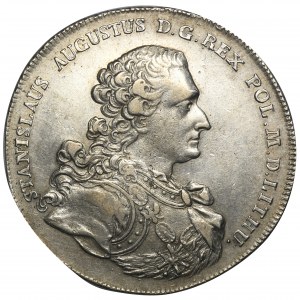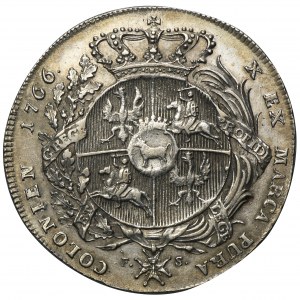Variety with a line between the letter G and the dot after D and a line crossing the dot after POL.
Dots after the initials FS, a dot after COLONIEN and a dot after the date. Alternating palm leaves.
Estimated mintage of 6,486 pieces.
Immaculately moved circulation piece. Background with lots of mint luster.
An attractive coin.
Obverse: bust of the king in armor.
STANISLAUS AUGUSTUS D GG REX POL M D LITHU
Reverse: a five-field shield of arms under a crown, around a wreath of oak and palm leaves wrapped in a sash, at the bottom a cross of the Order of the White Eagle
X EX MARCH PURA COLONIEN 1766
Diameter 43 mm, weight 27.82 g
During the first two years of the reign of Stanislaw Augustus, municipal mints operated in Gdansk and Torun (1765 and 1766). However, these cities were forced to close them. This is because the king intended to recover from the monetary chaos left over from the Saxon era and introduce a new monetary system. The reform came into effect in 1766, and the monetary circulation of the Republic included fine and full-value coins: ducats, thalers, zlotys, pennies and their fractions and multiples. The fact that these were full-value coins caused them to be pulled from the market and melted down into lower-quality Prussian coins. For this reason, the monetary system was revised twice, including changing the minting rate (1787 and 1794). During the reign of Stanislaw August, two state mints worked: the Cracow and Warsaw mints.
The Warsaw mint minted thalers according to three different minting ordinances. The monetary system introduced in 1766 established the production of 10 thalers from one cologne fine of pure silver (233.8123 g). They had a value of 8 zlotys. They weighed 28.057 g and contained 23.381 g of pure bullion. It soon became apparent that the coins issued by the Warsaw mint conforming to this standard were too good. They were pulled from the market en masse and exported abroad, and were punched into much inferior Prussian thalers in terms of silver content. The Polish minting authorities responded in 1787 by lowering the standard of thalers and half-thalers. They were now to be minted in thirteenth-gallon silver, were to weigh 27.570 g (semi-talars - 13.785 g) and contain 22.401 pure silver (semi-talars - 11.200 g). The direction of the reform was correct. However, the depth of the changes proved insufficient. Polish thalers continued to outperform Prussian ones. The procedure described above of pulling them off the market and melting them into inferior coinage was still profitable. The last reform was introduced during the Kosciuszko Uprising. The thalers of 1794 and 1795 were already worth 6 zlotys. They were minted from XI-gold silver, weighed 24.148 grams and contained 16.602 grams of pure silver. The 1794 monetary system no longer included semi-talars. The changes proved to be appropriate. Pulling thalers from the market and punching them into Prussian thalers was no longer profitable. However, the reform proved to be overdue. In 1795, the Polish state ceased to exist. In terms of artistic value, Stanislaw August's thalers are among the most beautiful Polish coins. Their designs were prepared and executed by the most outstanding engravers of the Stanislavski era. From 1766 the engraver of the stamps at the Warsaw mint was Jan Filip Holzhaeusser (d. 1792).
The 1766 thalers were of strong prestige significance to King Stanislaw August, and he was very keen that they should be beautiful, large coins that would fully reflect the solemnity of royal majesty. Before their production began, a competition was announced, in which medalists from Bern (Morikofer) and London (Pingo) took part. They sent beautiful designs, however, with too deep a relief, which disqualified their work as it would not fulfill its circulating function. In 1766, the king accepted the obverse with a bust of the king in armor, where he appeared with his head uncovered in a generous wig and without a crown. The dignity of the ruler was reflected by the Order of the White Eagle placed on an ornamental chain.









